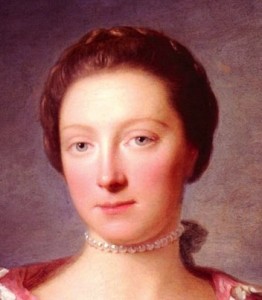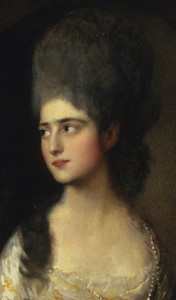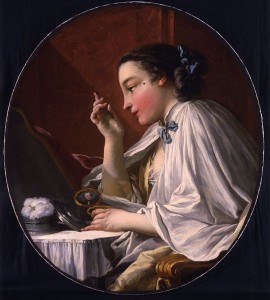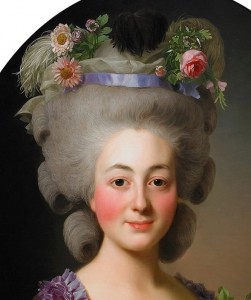 http://demodecouture.com/hairstyles-cosmetics-18th-century/
http://demodecouture.com/hairstyles-cosmetics-18th-century/ 
Beginning in the 17th century and continuing throughout the 18th century, both men and women in England and France wore obvious cosmetics. Gender differences were less important than class differences – cosmetics marked one as aristocratic and à la mode, and were adopted as well by those who were trying to rise in social status or become fashionable. Makeup was not intended to look natural – in fact, it was called “paint” — but instead, “…to represent one’s aristocratic identity as declaratively as possible through cosmetic artifice” (Hyde). Women and men showed their respectability and class through white skin, and heavy makeup was considered more respectable than naturally light skin.
Cosmetics also had practical aims – their use created what was considered an attractive face, and they could hide the effects of age, blemishes, disease, or sun.
In France, nearly all aristocratic women wore cosmetics (Louis XV’s dowdy queen Marie Leszcynska was one of the few who did not). In fact, the painting of the face was a key part of the public toilette, the informal ceremony where an aristocratic woman dressed her face and hair before an elect audience. French aristocratic women wore thick layers of white paint, large streaks of rouge, and beauty patches (mouches).
However, cosmetics were not limited to the upper echelons. Any bourgeois with aims of being à la mode would also have worn cosmetics (although perhaps not as heavily). Cosmetics declined in price and rose in availability over the century, and were even more frequently made at home by the less well to do. The middle classes tended to prefer tones of pink instead of red, and applied rouge in circular patterns rather than streaks.
In the 1760s, cosmetics were growing in such popularity that coiffeuses (vanity table sets) began to be heavily advertised, and dressing rooms were built facing north for the best light. By 1781, Frenchwomen used about two million pots of rouge a year.

The Duchess of Argyll wears very naturalistic cosmetics - light rouge, possibly white face makeup - in this portrait by Allan Ramsay, 1760.
A review of portraiture shows that Englishwomen were less likely to wear obviouscosmetics than Frenchwomen in the 1750s-60s (in other words, they were wearing cosmetics but with a more natural look) – but by the 1770s-80s, Englishwomen and Frenchwomen wore nearly identical amounts of cosmetics. In the 1780s, heavy use of cosmetics declined with the growing trend of a more “natural” look.
The key aspects of the 18th century cosmetic look were a complexion somewhere between white and pale, red cheeks in a large circular shape (particularly for French court wear) or upside down triangle, and red lips. There were two main cosmetics worn by most women and men: blanc and rouge.
Shiny white face paint was applied across the entire face and shoulders. The most popular white makeups used on the face were made of lead, which was popular for its opacity despite knowledge of lead poisoning. Kitty Fisher, a famous English beauty, died at age 23 (in 1767) from lead poisoning. Blanc could also be made from bismuth or vinegar. Veins could be traced with blue pencil to highlight the whiteness of the skin.

Miss Elizabeth Linley wears evident rouge on her cheeks and lips, and may have darkened her eyebrows. Thomas Gainsborough (English), 1775.
Red makeups were made of vermilion (ground from cinnabar and including mercury) or creuse (made by exposing lead plates to the vapor of vinegar); both are toxic. Vegetable sources for rouge included safflower, wood resin, sandalwood, and brazilwood. These would be mixed with greases, creams, or vinegars to create a paste. Court ladies wore rouge on the cheeks in wide swaths from the corner of the eye to the corner of the lips. Bourgeois and provincial nobility wore neater, circular dabs at the center of the cheek to highlight the eyes and whiteness of the skin.
Lips could be reddened with distilled alcohol or vinegar. By mid-century, red pomades (some in stick forms) for lips were being sold. The shades of red seen on lips varied between pink and coral, occasionally veering into burgundy.
Eyes sometimes had a bit of reddish color around them, probably caused by contrast with the white makeup or a reaction to the lead in blanc, but were otherwise left bare. Eyebrows were half moon shaped with tapered ends, and could be darkened with kohl, elderberries, burnt cork, or lampblack (soot from oil lamps). Court men and women sometimes plucked and painted their eyebrows, or occasionally wore false eyebrows made of mouse fur.
Beauty patches (“mouches”) (made of silk velvet, satin, or taffeta and attached with glue) were part of a formal and/or aristocratic look. Their height of popularity was in the 17th century, but they still continued to be worn in the 18th century. They were meant to heighten the contrast with white skin. There were numerous sizes and shapes, worn in various positions with supposed meanings. In England, they took on a political meaning, with supporters of Whigs and Tories wearing patches on opposite sides of the face. Occasionally, patches could be worn together in designs, like trees or birds on the cheek of forehead.
In the 1750s-60s, Frenchwomen generally wore an extremely artificial look, with cosmetics used heavily and obviously. The face was extremely pale, with rouge applied in large, round circles on the cheeks. The eyes were left bare, sometimes with darkened brows, and lips were reddish. In contrast, Englishwomen usually appeared somewhat naturalistic, with cosmetics used sparingly and discreetly. The face was pale but not extreme, with the option of rouge applied in an upside down triangular shape, from the cheekbones almost to the jawline (similarly to how naturally pale women flush). Eyes were bare, and lips were reddish.




This comment has been removed by a blog administrator.
ReplyDeleteI'm still confused why you have plagiarized my article. Perhaps you could delete this post, or rewrite it with a summary you've written in your own words and a link to my post. As someone who works in writing and publishing, I'm really surprised that you don't recognize plagiarism as the stealing that it is.
ReplyDeleteI replied on your site. this article is linked to your site as attribution. cross posting raises all of our rankings. if you'd like this removed please advise nquinn@hvc.rr.com
ReplyDelete